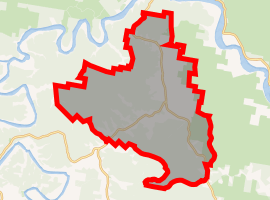Maroota, New South Wales
Maroota is a suburb to the north-west of Sydney, New South Wales, Australia. Maroota is located 49 kilometres north-west of the Sydney central business district, in the local government areas of The Hills Shire and Hornsby Shire.
| Maroota New South Wales | |||||||||||||||
|---|---|---|---|---|---|---|---|---|---|---|---|---|---|---|---|

| |||||||||||||||
| Population | 291 (2011 census)[1] | ||||||||||||||
| Postcode(s) | 2756 | ||||||||||||||
| Location | 49 km (30 mi) northwest of Sydney CBD | ||||||||||||||
| LGA(s) | The Hills Shire and Hornsby Shire | ||||||||||||||
| State electorate(s) | Hawkesbury | ||||||||||||||
| Federal Division(s) | Berowra | ||||||||||||||
| |||||||||||||||
Maroota is located at a high point, about 200 m above sea-level, on the ridge-following Great Northern Road (now renamed Old Northern Road). This was the main early road, constructed by convict gangs, from Sydney north to Singleton in the Hunter Valley. It is the last northwest suburb of Sydney.
Maroota is situated on, and owes its nature to, a residual mass of Tertiary river sand deposit (the Maroota Sand) which geologists think may be the oldest known remnant of the largest waterway in the Sydney region, the Nepean-Hawkesbury system.
History
The first attempt to settle Maroota, as a soldier-settlement, failed totally. Some of the soldiers leaving the Army during an across-the-Empire downsizing in the wake of the Napoleonic wars bought land (sight-unseen) at Maroota, hoping to begin new lives as farmers. However, all of them as soon as they visited their new purchases were shocked and disappointed with what they found. They protested to the government that such barren sandy soil could never support them and their families, asking for replacement land to be granted to them elsewhere. What these early men did not know was that at but a short depth below surface the Maroota Sand was rich in groundwater. Later on, the land proved quite good and profitable for a variety of farming and orchard growing applications, and for limited grazing, once its true values and potential were realised.
A Weaver's Post Office was open by 1 January 1927. In 1956 its name was changed to Maroota, and it was closed in 1969.[2]
In recent years Maroota has undergone transformation, becoming a growing centre of sand mining. As Sydney's major sand and gravel quarrying centre, at Castlereagh just north of Penrith, nears the end of its life Maroota becomes increasingly important for supplying sand to many users in the metropolis.
In 1970 Sydney's largest naturist club, Kiata Country Club, was established at South Maroota.
One place study, commenced in 2005, which seeks to draw together the history of Maroota, especially the natural and Aboriginal history, is at http://maroota.sands.googlepages.com
Heritage listings
Maroota South has a number of heritage-listed sites, including:
- Wisemans Ferry Road: Great Drain[3]
References
- Australian Bureau of Statistics (31 October 2012). "Maroota (State Suburb)". 2011 Census QuickStats. Retrieved 7 November 2012.

- Premier Postal History. "Post Office List". Retrieved 1 June 2012.
- "Great Drain and two house sites". New South Wales State Heritage Register. Office of Environment and Heritage. H01402. Retrieved 18 May 2018.
External links
- Joan Rowland (2008). "Maroota". Dictionary of Sydney. Retrieved 28 September 2015. [CC-By-SA]